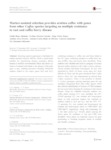Por favor, use este identificador para citar o enlazar este ítem:
http://www.alice.cnptia.embrapa.br/alice/handle/doc/1061004Registro completo de metadatos
| Campo DC | Valor | Lengua/Idioma |
|---|---|---|
| dc.contributor.author | ALKIMIM, E. R. | pt_BR |
| dc.contributor.author | CAIXETA, E. T. | pt_BR |
| dc.contributor.author | SOUSA, T. V. | pt_BR |
| dc.contributor.author | PEREIRA, A. A. | pt_BR |
| dc.contributor.author | OLIVEIRA, A. C. B. de | pt_BR |
| dc.contributor.author | ZAMBOLIM, L. | pt_BR |
| dc.contributor.author | SAKIYAMA, N. S. | pt_BR |
| dc.date.accessioned | 2017-01-17T11:11:11Z | pt_BR |
| dc.date.available | 2017-01-17T11:11:11Z | pt_BR |
| dc.date.created | 2017-01-17 | pt_BR |
| dc.date.issued | 2017 | pt_BR |
| dc.identifier.citation | Molecular Breeding, v. 37, n. 6, p. 1-10, jan. 2017. | pt_BR |
| dc.identifier.uri | http://www.alice.cnptia.embrapa.br/alice/handle/doc/1061004 | pt_BR |
| dc.description | Selecting superior genotypes is facilitated by marker-assisted selection (MAS), which is particularly suitable for transferring disease resistance alleles because it nullifies environmental effects and allows selection of resistant individuals in the absence of the pathogen or race, enabling preventive breeding. Molecular markers linked to two major genes (SH3 and SH?), conferring resistance to coffee rust, and those linked to the Ck-1 gene, conferring resistance to coffee berry disease (CBD), have previously been identified. These markers were validated and used in a progeny of crosses between Indian selections with Coffea arabica cultivars. Eleven resistant individuals homozygous for SH3 were identified by MAS. Of these, seven carry SH? from Híbrido de Timor and the gene introduced from Coffea liberica (SH3). SH? was characterized as derived from Coffea canephora. Thus, it was possible to identify C. arabica genotypes carrying important genes for rust resistance introgressed from other coffee species. MAS also allowed identification of sources of CBD resistance for use in preventive breeding for resistance to this serious disease. Using two validated molecular markers, two coffee plants carrying Ck-1 were identified: the UFV 328-60 genotype (F2) was resistant and homozygous based on both molecular markers but exhibited no markers related to SH3 and SH?, and the UFV 317- 12 genotype (F1) was resistant and homozygous but resistant and heterozygous based on CBD-Sat207 and CBD-Sat235, respectively. Along with possessing Ck- 1, the latter carries SH?. Overall, plants carrying different genes for resistance to rust and CBD were identified. These plants are important sources for gene pyramiding in breeding programs aimed at multiple and durable resistance. | pt_BR |
| dc.language.iso | por | pt_BR |
| dc.rights | openAccess | pt_BR |
| dc.subject | Preventive breeding | pt_BR |
| dc.subject | Gene pyramiding | pt_BR |
| dc.subject | Indian selections | pt_BR |
| dc.title | Marker-assisted selection provides arabica coffee with genes from other Coffea species targeting on multiple resistance to rust and coffee berry disease. | pt_BR |
| dc.type | Artigo de periódico | pt_BR |
| dc.date.updated | 2017-12-15T11:11:11Z | pt_BR |
| dc.subject.thesagro | Hemileia Vastatrix | pt_BR |
| dc.subject.nalthesaurus | Colletotrichum kahawae | pt_BR |
| riaa.ainfo.id | 1061004 | pt_BR |
| riaa.ainfo.lastupdate | 2017-12-15 -02:00:00 | pt_BR |
| dc.contributor.institution | EMILLY RUAS ALKIMIM, UFV; EVELINE TEIXEIRA CAIXETA, SAPC; TIAGO VIEIRA SOUSA, UFV; ANTÔNIO ALVES PEREIRA, EPAMIG; ANTONIO CARLOS BAIAO DE OLIVEIRA, SAPC; LAÉRCIO ZAMBOLIM, UFV; NEY SUSSUMU SAKIYAMA, UFV. | pt_BR |
| Aparece en las colecciones: | Artigo em periódico indexado (SAPC)  | |
Ficheros en este ítem:
| Fichero | Descripción | Tamaño | Formato | |
|---|---|---|---|---|
| Markerassistedselectionprovides.pdf | 924.73 kB | Adobe PDF |  Visualizar/Abrir |









